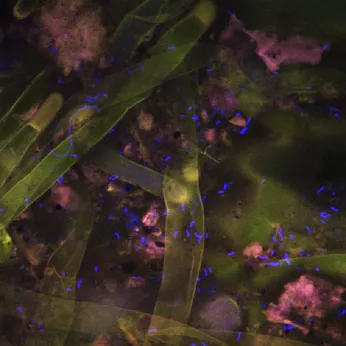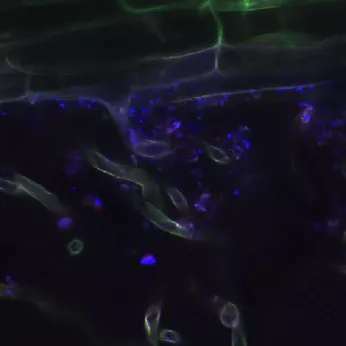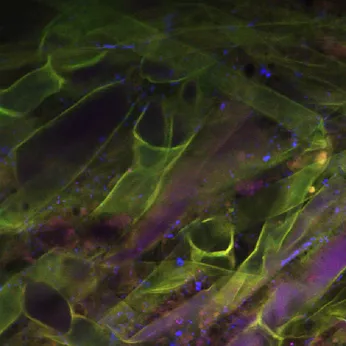SP12: Soil Microbiomes




Head: Prof. Dr. Michael Schloter
Affiliated Post-Doc: Dr. Stefanie Schulz
Affiliated PhD Student: Safiya Yakubu
Background
Soils are considered as a hotspot for microbial diversity, since 1 g of soil may harbor more than 109 microorganisms which belong to up to 5000 species. The enormous microbial diversity forms the basis for a large number of ESS provided by soils, including carbon sequestration, degradation of pollutants, safeguarding of drinking water resources, and support of plant growth. Besides, the resilience of soils is strongly linked to the dazzling array of bacteria, archaea, fungi and other eucaryotes. However, like for many other biotas, a strong decline in microbial richness has been observed in the past decades as a result of global change, which is often associated with a degradation of soils, and a loss of ecosystem functions. Recent studies indicate that reduced microbial diversity in the environment acts as a driver for several common diseases including infections and allergies. Thus, strategies are needed to stabilize the soil microbiome to improve both environmental and human health. In urban environments, such strategies are needed, as sealing and degradation and pollution of soils induce a strong decline in microbial diversity. Generating artificial biodiversity ‘hotspots’ in urban environments is therefore a valid mitigation strategy. So far, SUDS can be considered as ‘cold spots’ for biodiversity with spare or no vegetation, low microbial diversity and activity, and an overall lack of complex food web structures in the soil.
Objectives
In the frame of this project, we want to test different strategies to improve microbial diversity and activity of SUDS, to generate positive feedback loops for these ecosystems, and to transform these cold spots into hotspots for biodiversity.
The objectives are:
(O1) Investigating improved nutrient status in SUDS for microbial diversity and activity;
(O2) Assessing the role of the soil microbiome of infiltration swales for improving stress tolerance of plants and the increase of above-ground biodiversity;
(O3) Describing the impact of soil biodiversity of SUDS for improved filtering of pollutants;
(O4) Analyzing the impact of heavy metals derived from metal roofs and rain pipes in combination with increased microbial activities (as a consequence of the improved nutrient status) for the coevolution of antibiotic-resistant microbes in the soil.
We predict that:
(H1) An increase in the nutrient content in the soil, e.g., by the application of composts, will induce shifts in the microbial stoichiometry of C:N:P:S and improve microbial activities;
(H2) Increases in microbial activity will indirectly (degradation of pollutants) and directly (improving stress tolerance) affect plant performance and increase plant diversity beyond hyperaccumulating plants for heavy metals;
(H3) An increase in plant diversity is associated with an increase in microbial diversity;
(H4) Enhanced microbial activities related to the degradation of biocides trigger the co-evolution of antibiotic-resistant microbiota in environments with high loads of heavy metals.
Dissertation: Modulating the microbiome of infiltration swales – Changes and risks for environmental- and human health.
Methods:
In close collaboration with SP10, SP11, and SP13 we will investigate various concepts to improve microbial biodiversity and ESS in SUDS. Stage 1 will analyze the consequences of the selected amendments described in SP10 and SP11 for the diversity of bacteria, fungi, archaea and protists, their functional traits as well as their activities. A special focus will be given to that microbiota, which is capable to degrade complex organic materials introduced as pollutants. To generate maximal synergies with SP10 and SP11, samples from the experiments performed in these two subprojects will be analyzed. In stage 2 we will assess the microbiome associated with the plants and plant mixtures proposed by SP13. We will compare the plant-associated microbiome of plants grown in soils with differing degrees of pollution to identify the microbiota that is most affected by pollution. It is planned to improve plant growth in SUDS by the application of selected bioinocula to substitute the functional traits of the most pollutant-sensitive microbiota. In stage 3 consequences of heavy metals and pollutants for the development of multi-drug resistant microbiota should be analyzed focusing on established SUDS. The risk of an increase of microbiota harboring genes for improved resistance against antibiotics located on mobile genetic elements should be described. To perform microbiome analysis in the three stages of the project, state-of-the-art molecular methods will be applied (e.g., barcoding, metagenomics, meta-transcriptomics). High throughput isolation-based methods will be applied to develop new bioinocula improving plant growth in polluted environments.
Outlook:
In the Period II, the microbiome of SUDS will be investigated under field conditions in experimentally manipulated SUDS in the City of Munich.
Execution: Michelle Kligman
Insects are essential for maintaining the balance and functioning of ecosystems. They contribute to various ecological processes, such as pollination, seed dispersal, and nutrient cycling, which are crucial for the health and resilience of natural habitats. Additionally, insects play a crucial role in maintaining biodiversity by occupying specific niches within ecosystems and participating in complex food webs. Their presence ensures the stability and sustainability of ecosystems, making them vital for conserving natural environments. With increasing efforts to promote biodiversity in urban environments and the subsequent implementation of plants at different scales (from facades to parks), cities also become attractive more and more attractive for insects. Furthermore, as a result of climate change, there are strong indications for the invasion of new species, which so far were mainly described for warmer regions to cities in temperate areas. From the biodiversity perspective, this effect is highly desirable for promoting ecosystem services and resilience. From the human health perspective, this implementation of insects might be more problematic, as they may act as vectors for new zoonotic diseases in the future, and the contact with the urban human population might be closer than in rural areas, which strongly promotes the spread of such diseases. In addition, because of their lifestyle and co-selection, insects might harbor a large number of microbes that are resistant to antibiotics, which can, on the one hand, hinder the treatment of patients with new zoonotic diseases and, on the other hand, promote the spread of antibiotic resistance genes in urban environments.
Thus, this PhD project will analyze the microbiome of selected insect species that are typical for the urban environment of Munich. We collect insects of various species and describe their microbiome both assessing structural and functional aspects, with a strong focus on antimicrobial resistance genes. We will focus on in sustainable urban drainage systems (SUDS), as here new hotspots for biodiversity should be created, resulting both an increase in abundance and diversity of insects. To assess the impact of different levels of urbanization, we will sample SUDS along a gradient from downtown Munich to its suburbs.